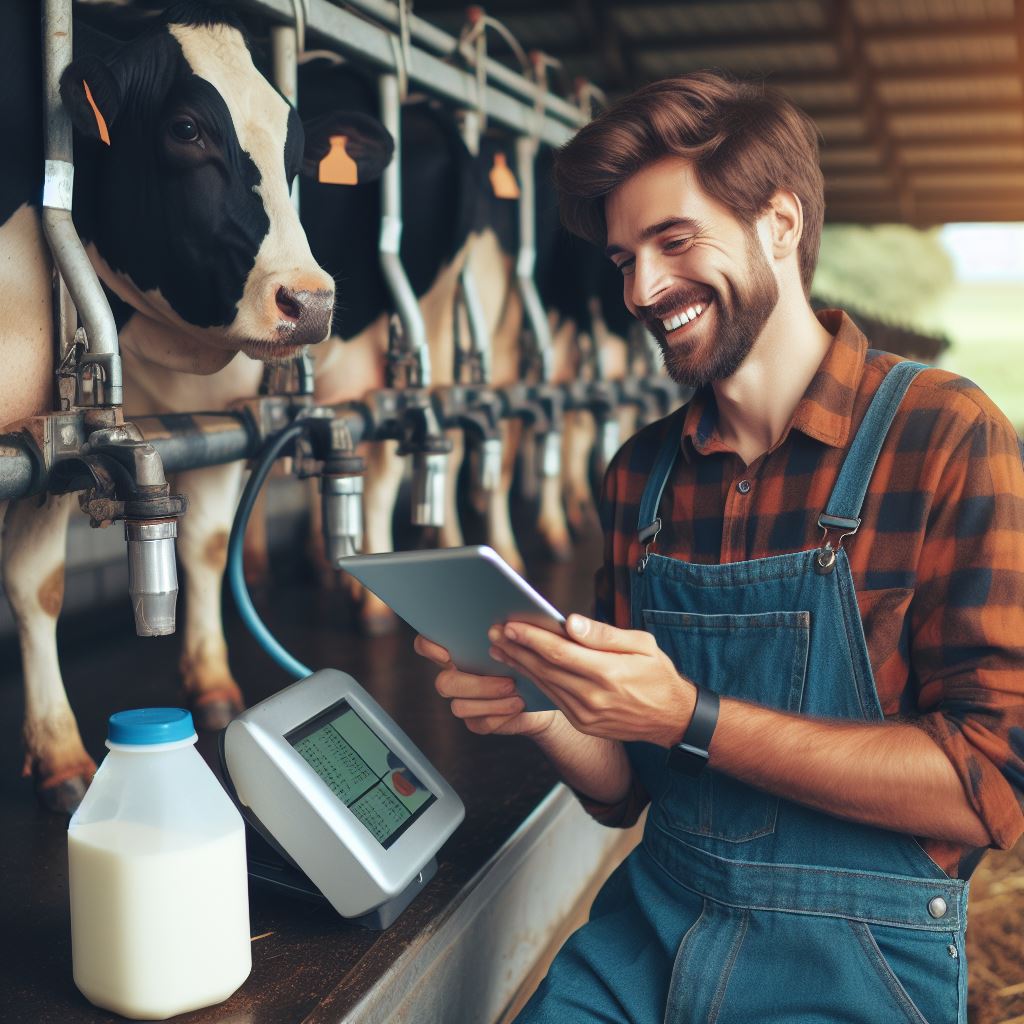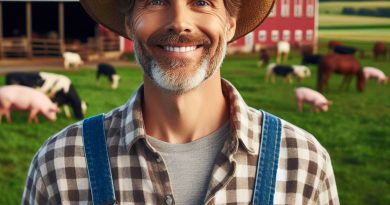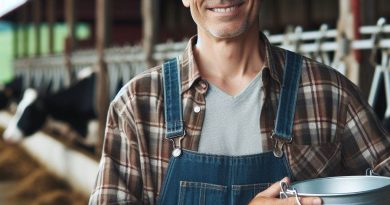Latest Milking Tech: Revolutionizing Dairy Farms
Last Updated on February 19, 2024
Introduction
Milking technology plays a vital role in modernizing dairy farms and optimizing milk production processes.
Advancements in milking tech have revolutionized the dairy industry, leading to increased efficiency and productivity.
In recent years, significant innovations have transformed traditional milking practices into sophisticated, automated systems.
These advancements have streamlined milking operations, reduced labor requirements, and improved animal welfare.
From robotic milking machines to smart sensors and monitoring devices, dairy farms are embracing cutting-edge technology.
These technologies enable precise monitoring of milk production, cow health, and milk quality in real time.
Moreover, they allow for personalized care and management of individual cows, optimizing their well-being and productivity.
In this blog post, we’ll delve into the latest milking technologies shaping the future of dairy farming.
We’ll explore how these innovations are revolutionizing milk production, enhancing farm sustainability, and driving profitability.
Join us as we uncover the transformative impact of the latest milking tech on dairy farms worldwide.
Traditional milking methods
The conventional milking practices
- Hand milking: This is the oldest and most basic method of extracting milk from dairy cows. It involves manually squeezing the teats to release the milk.
- Bucket milking: In this method, a metal or plastic bucket is placed under the cow’s udder, and the milk is directly milked into the bucket by hand.
- Tied-stall system: This system involves tying the cow in a stall using a rope or chain, limiting its movement during milking.
- Automatic milking system: This traditional method utilizes a mechanical device that attaches to the cow’s teats and slowly extracts the milk.
- Milking parlors: These are specially designed areas where multiple cows are milked simultaneously, using either hand or machine milking methods.
The limitations and challenges faced by farmers
- Labor-intensive: Traditional milking methods require significant manual labor, as each cow needs to be milked individually. This can be time-consuming and exhausting for farmers.
- Inefficiency: Hand milking and bucket milking are not as efficient as modern milking technologies, resulting in slower milk extraction and lower productivity.
- Animal discomfort and stress: Tying cows in stalls or using mechanical devices can cause discomfort and stress to the animals, affecting their overall well-being.
- Hygiene concerns: Traditional milking methods may increase the risk of contamination and mastitis due to the manual handling of milk and the potential lack of proper sanitation.
- Difficulty in monitoring individual cow health: With traditional methods, it can be challenging for farmers to closely monitor the health and milk production of each cow.
- Lack of automation: Traditional milking methods usually rely on manual labor, limiting the ability to automate the milking process and optimize efficiency.
- Increased physical strain on farmers: The repetitive nature of traditional milking methods can lead to musculoskeletal injuries and physical strain on farmers.
- Time constraints: Traditional milking practices can be time-consuming, especially when there is a large number of cows to be milked, reducing farmers’ flexibility in managing other farm tasks.
- Limited scalability: Traditional methods may not be suitable for large-scale dairy farms due to their inefficiency and labor requirements.
- Economic impact: The limitations of traditional milking methods can affect milk production levels, profitability, and overall farm sustainability.
In general, traditional milking methods have been practiced for centuries but have limitations and challenges that can hinder efficiency and milk production on dairy farms.
With the advent of new milking technologies, farmers now have the opportunity to revolutionize their operations and optimize milk extraction while ensuring the comfort and well-being of their cattle.
Read: Solar Power in Livestock Farming: A Guide
Overview of the latest milking technology
Introduction to automated milking systems
Automated milking systems, also known as robotic milking, have revolutionized the way dairy farms operate.
These high-tech systems automate the milking process, eliminating the need for manual labor and increasing efficiency.
How these systems function and their benefits
Robotic milking systems work by utilizing sensors, cameras, and computer software to identify and milk cows on their own.
The process begins when cows voluntarily enter the milking station, which is equipped with robotic arms.
The sensors scan the cow’s udder to locate the teats and attach suction cups for milking.
This entire process is painless and stress-free for the cows, allowing them to be milked whenever they desire.
Benefits
- Increased milk production: Milking more frequently boosts yield, while customizable settings optimize milk quality for consistent milking.
- Improved animal welfare: The technology lets cows choose milking times, reducing stress. It offers data on health and behavior for monitoring.
- Labor savings: These systems require minimal human intervention, freeing up farmers’ time and reducing the need for manual labor.
- Better farm management: These systems’ software records and analyzes milk quantity, quality, and cow health data, aiding informed decisions and operation optimization.
- Promote sustainability: Minimizing water, energy, and chemical use promotes eco-friendly dairy farming, benefiting the environment and reducing antibiotic use.
Overall, the latest milking technology, specifically automated milking systems, has transformed dairy farms.
These innovative systems enhance milk production, improve animal welfare, save labor, and promote sustainable farming practices.
As technology continues to advance, the future of dairy farming looks promising with these cutting-edge milking systems.
Read: Smart Barns: Integrating Tech in Livestock Care
Advantages of automated milking systems
A revolution in the dairy farming industry, automated milking systems have brought numerous advantages to farmers.
Increased milk production and quality
- Automated milking systems have led to a significant increase in milk production, benefiting dairy farmers immensely.
- The advanced technology optimizes milking processes, ensuring efficient and consistent milk extraction from cows.
- These systems enable frequent milking sessions throughout the day, stimulating cows to produce more milk.
- In addition, automated milking ensures hygienic milking conditions, resulting in higher milk quality.
Reduction in labor and operating costs
Automated milking systems have significantly reduced the need for manual labor on dairy farms. Previously, milking cows required a considerable workforce, but automation has revolutionized this aspect.
Farmers no longer need to spend countless hours milking cows manually, increasing work efficiency and productivity.
The reduced labor costs contribute to overall cost savings for dairy farm operations.
Moreover, these systems require minimal maintenance, further lowering operating costs for farmers.
Improved animal welfare and health monitoring
- Automated milking systems have greatly enhanced animal welfare by offering a more comfortable milking experience for cows.
- The technology ensures gentle and efficient milking, minimizing stress and discomfort for the animals.
- Cows are free to be milked whenever they choose, without experiencing the usual physical constraint of traditional milking.
- Furthermore, these systems include health monitoring features that alert farmers to any potential issues with individual cows.
- Through early detection, farmers can provide timely veterinary care, leading to improved overall health of the herd.
In summary, automated milking systems have revolutionized dairy farms by providing numerous advantages to farmers.
The increased milk production and enhanced milk quality contribute to higher profits for the farm.
Furthermore, the reduction in labor costs and operating expenses improves the economic viability of dairy farming.
Lastly, automated milking systems prioritize animal welfare and enable effective health monitoring, ensuring the well-being of the cows.
Therefore, these technological advancements have transformed the dairy industry for the better.
Read: Wool vs. Hair Sheep: What’s Best?

Different types of automated milking systems
Robotic milking machines
How robots handle the milking process
Robotic milking machines are designed to mimic the actions of a human milker.
They have a robotic arm that attaches to the cow’s udder, cleans it, and then attaches the milking cups. The robot then monitors and controls the milking process.
Benefits of using this type of system
- Using robotic milking machines has several advantages.
- Firstly, it reduces the labor required to milk cows as the robots can work 24/7.
- Secondly, it allows for individualized milking, adjusting based on each cow’s specific needs.
- Moreover, the robots can collect data on milk yield, conductivity, temperature, and other parameters, enabling efficient herd management and early detection of health issues.
Rotary milking parlors
How rotary parlors work
Rotary milking parlors are large rotating platforms with multiple milking stations.
Cows walk onto the platform, and as it slowly rotates, they are milked by a team of milkers.
Milkers attach milking cups, monitor the process, and remove the cups once milking is complete before the cow exits the platform.
Advantages of this system for large-scale dairy farms
- Large-scale dairy farms benefit from rotary milking parlors in several ways.
- Firstly, they allow for high throughput, as multiple cows can be milked simultaneously.
- Secondly, they require less labor compared to individual milking, as a team of milkers can efficiently handle the cows.
- Moreover, the platform keeps cows calm and minimizes stress, which improves milk production.
In closing, the advent of automated milking systems has revolutionized dairy farms.
Robotic milking machines offer the benefits of reduced labor, individualized milking, and enhanced herd management.
On the other hand, rotary milking parlors provide high throughput, require less labor, and ensure cow comfort in large-scale dairy operations.
Incorporating these technologies allows dairy farmers to streamline their milking processes and increase efficiency.
Case studies of dairy farms using the latest milking technology
Example 1: Strafford Dairy Farm’s experience with robotic milking machines
- Strafford Dairy Farm, a traditional family-owned dairy farm located in Vermont, made the bold decision to transition to using robotic milking machines.
- The farm invested in state-of-the-art milking robots that are designed to efficiently milk the cows and collect important data about their health and productivity.
- The transition to automation was not without its challenges. The farmers had to make adjustments to their barn layout and infrastructure to accommodate the robots.
- However, the positive outcomes quickly outweighed the initial difficulties. The robots allowed the cows to be milked on their schedule, reducing stress and increasing milk production.
- The farm’s overall milk quality also improved as the robots provided consistent and gentle milking, resulting in cleaner milk with fewer contaminants.
- The farmers were impressed with the robots’ ability to monitor each cow individually, detecting early signs of health issues and alerting the farmers for prompt intervention.
- Furthermore, the farmers appreciated the time and labor savings brought by the robots.
- They were able to focus on other essential aspects of farm management instead of spending hours milking cows.
- The farmers also noted that their job satisfaction had increased since adopting the robots.
- They were no longer tied to a strict milking schedule and had more flexibility in their daily routines.
Example 2: Bleu Mont Dairy’s implementation of a rotary milking parlor
- Bleu Mont Dairy, a renowned artisan cheesemaker in Wisconsin, decided to implement a rotary milking parlor as part of their commitment to sustainable farming practices.
- The decision-making process involved careful research of available milking technologies, farm-specific requirements, and consultation with experts in the field.
- The farm’s adoption of a rotary milking parlor was based on the belief that such a system would optimize efficiency and improve the welfare of their cows.
- Challenges arose during the implementation phase, particularly in training the cows to comfortably enter and exit the rotary parlor.
- However, with time and patience, the cows adjusted to the new system, and the farm started to witness significant successes.
- The rotary milking parlor allowed for a higher throughput of cows, reducing waiting times and improving overall efficiency in the milking process.
- The cows appeared less stressed during milking, thanks to the gentle rotation mechanism and a calm environment within the parlor.
- The adoption of the rotary parlor also led to improved milk quality, as the system ensured consistent and hygienic milking procedures.
- Bleu Mont Dairy further observed that labor efficiency had improved, with fewer staff required to operate the milking parlor compared to traditional methods.
- Despite adoption challenges, the farm’s investment in revolutionary milking tech positioned them as industry leaders, boosting productivity and sustainability.
These case studies provide real-world examples of how dairy farms can revolutionize their milking processes through the use of the latest technology.
Whether through robotic milking machines or rotary milking parlors, farms can benefit from increased efficiency, improved milk quality, and enhanced animal welfare.
Considerations and challenges of adopting milking technology
Initial costs and return on investment
- Implementing milking technology involves significant initial investments in equipment and infrastructure.
- Dairy farmers need to carefully assess the financial feasibility and potential return on investment.
- Factors such as herd size, milk production, and market demand should be considered.
- While the initial costs may be high, the long-term benefits can lead to improved profitability.
Training and education for farmers and workers
- Farmers and workers require proper training and education to effectively operate milking technology.
- They need to understand the technology’s functionality, maintenance procedures, and troubleshooting.
- Training programs delivered by equipment manufacturers or industry experts can bridge knowledge gaps.
- Ongoing education ensures efficient use of the technology and optimal milk quality.
Maintenance and troubleshooting
- Regular maintenance is crucial to ensure the smooth functioning of milking technology.
- Farmers must be prepared to allocate time, resources, and staff for maintenance tasks.
- Equipment breakdowns or malfunctions can disrupt milking operations and impact productivity.
- Farmers should have access to reliable technical support and troubleshooting assistance.
- Creating a contingency plan and having backup equipment can minimize potential downtime.
By carefully considering and addressing these challenges, dairy farmers can successfully adopt milking technology.
The benefits, including improved efficiency, milk quality, and profitability, make it a worthy investment.
Future prospects and trends in milking technology
Predictions for further advancements in the industry
- Continuous development of robotic milking systems that can monitor cow health and milk quality in real-time.
- Integration of artificial intelligence and machine learning algorithms to optimize milking processes and herd management.
- Advancements in teat-cleaning technology to reduce the risk of bacterial contamination and improve udder health.
- Increased automation in milking parlors, with the use of automated feeding systems and smart gates.
- Incorporation of virtual reality and augmented reality technology to train and educate farmers on milking techniques.
Potential impact on dairy farming practices and profitability
- Increased efficiency and productivity: The adoption of advanced milking technology can streamline milking processes, leading to increased milk production and reduced labor costs.
- Improved animal welfare: Milking robots grant cows freedom, reducing stress and enhancing well-being by allowing them to choose when to be milked.
- Enhanced milk quality and safety: Technological advancements in milking equipment can minimize the risk of bacterial contamination and ensure hygienic milk production.
- Better monitoring and management: Smart milking systems offer real-time cow health data, aiding prompt issue detection and improving herd management for farmers.
- Cost savings: The automation of milking processes can result in significant savings on labor and operational expenses, increasing profitability for dairy farmers.
In closing, the future of milking technology looks promising, with continuous advancements expected to enhance efficiency, animal welfare, milk quality, and overall profitability in dairy farming.
The integration of robotics, AI, and other innovative technologies will revolutionize the industry, allowing farmers to optimize their operations and meet the increasing demands of a growing population.
As we move forward, dairy farmers must stay abreast of these emerging trends and embrace the opportunities they present for sustainable and profitable dairy farming practices.
Read: Grants for Farmers: 2024 Application Tips
Conclusion
Milking technology has revolutionized the dairy industry, making it more efficient and sustainable.
It has made a huge impact on milk production, animal welfare, and farmer profitability.
Farmers should keep up with the latest advancements in milking technology to stay competitive in the market.
Embracing these innovations will bring numerous benefits to their farms.
With the continuous development of milking technology, the future of dairy farming looks promising.
These advanced systems will further enhance milk quality, streamline operations, and improve the overall efficiency of dairy farms.


